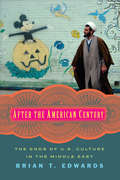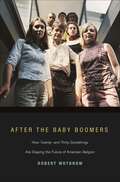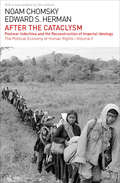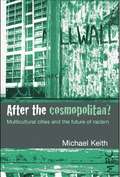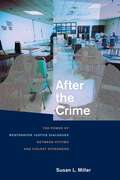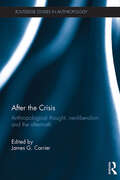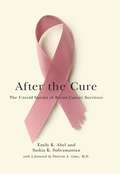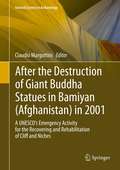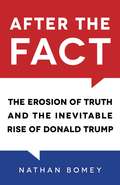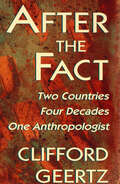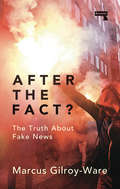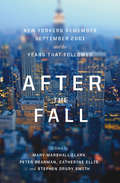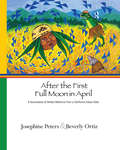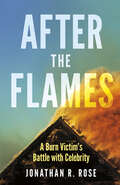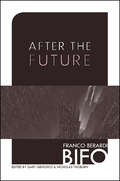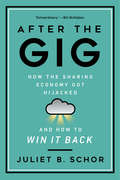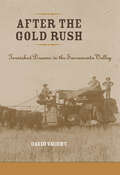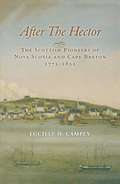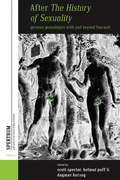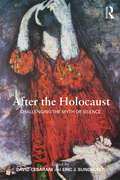- Table View
- List View
After the American Century: The Ends of U.S. Culture in the Middle East
by Brian EdwardsWhen Henry Luce announced in 1941 that we were living in the "American century," he believed that the international popularity of American culture made the world favorable to U.S. interests. Now, in the digital twenty-first century, the American century has been superseded, as American movies, music, and video games are received, understood, and transformed. <P><P>How do we make sense of this shift? Building on a decade of fieldwork in Cairo, Casablanca, and Tehran, Brian T. Edwards maps new routes of cultural exchange that are innovative, accelerated, and full of diversions. Shaped by the digital revolution, these paths are entwined with the growing fragility of American "soft" power. They indicate an era after the American century, in which popular American products and phenomena—such as comic books, teen romances, social-networking sites, and ways of expressing sexuality—are stripped of their associations with the United States and recast in very different forms. Arguing against those who talk about a world in which American culture is merely replicated or appropriated, Edwards focuses on creative moments of uptake, in which Arabs and Iranians make something unexpected. He argues that these products do more than extend the reach of the original. They reflect a world in which culture endlessly circulates and gathers new meanings.
After the Ancestors
by Andrew BeattySet on an isolated Indonesian island, this is the gripping true story of a fieldworker's experience of living in a tribal society during a period of crisis. Featuring a cast of unforgettable characters, After the Ancestors follows a bitter feud between rivals as it escalates into murder, intrigue and revenge. A vivid account of life within a radically different world, it also portrays a unique culture undergoing the transition from tribalism to modernity. A century of alien rule has left the island, once famous for its warrior ethos, with a hybrid culture. As the possibilities for heroic action recede, men raised to be orators and over-reachers rather than church elders and peasants find themselves occupying a stage too small for their personalities. 'Where can we turn', asks one tribesman, 'we who come after the ancestors?' A revenge tragedy for modern times, After the Ancestors will be enjoyed by anthropologists and general readers alike.
After the Baby Boomers: How Twenty- and Thirty-Somethings Are Shaping the Future of American Religion
by Robert WuthnowMuch has been written about the profound impact the post-World War II baby boomers had on American religion. But the lifestyles and beliefs of the generation that has followed--and the influence these younger Americans in their twenties and thirties are having on the face of religion--are not so well understood. It is this next wave of post-boomers that Robert Wuthnow examines in this illuminating book. What are their churchgoing habits and spiritual interests and needs? How does their faith affect their families, their communities, and their politics? Interpreting new evidence from scores of in-depth interviews and surveys, Wuthnow reveals a generation of younger adults who, unlike the baby boomers that preceded them, are taking their time establishing themselves in careers, getting married, starting families of their own, and settling down--resulting in an estimated six million fewer regular churchgoers. He shows how the recent growth in evangelicalism is tapering off, and traces how biblical literalism, while still popular, is becoming less dogmatic and more preoccupied with practical guidance. At the same time, Wuthnow explains how conflicts between religious liberals and conservatives continue--including among new immigrant groups such as Hispanics and Asians--and how in the absence of institutional support many post-boomers have taken a more individualistic, improvised approach to spirituality. Wuthnow's fascinating analysis also explores the impacts of the Internet and so-called virtual churches, and the appeal of megachurches. After the Baby Boomers offers us a tantalizing look at the future of American religion for decades to come.
After the Cataclysm: Postwar Indochina and the Reconstruction of Imperial Ideology (The Political Economy of Human Rights #2)
by Noam Chomsky Edward S. HermanVolume two of the influential study of US foreign policy during the Cold War—and the media&’s manipulative coverage—by the authors of Manufacturing Consent. First published in 1979, Noam Chomsky and Edward Herman&’s two-volume work, The Political Economy of Human Rights, is a devastating analysis of the United States government&’s suppression of human rights and support of authoritarianism in Asia, Africa and Latin America during the 1960s and 70s. Still one of the most comprehensive studies of the subject, it demonstrates how government obscured its role in torture, murder and totalitarianism abroad with the aid of the news media. In the first volume, Chomsky and Herman focus on US terror in Indochina. In volume two, After the Cataclysm, the authors examine the immediate aftermath of those actions, with special focus on the Khmer Rouge takeover of Cambodia. Throughout, the authors track the media response to the US interventions—a mixture of willful silence and Orwellian misrepresentation.
After the Cosmopolitan?: Multicultural Cities and the Future of Racism
by Michael KeithAfter the Cosmopolitan? argues that both racial divisions and intercultural dialogue can only be understood in the context of the urbanism through which they are realized. All the key debates in cultural theory and urban studies are covered in detail: the growth of cultural industries and the marketing of cities social exclusion and violence the nature of the ghetto the cross-disciplinary conceptualization of cultural hybridity the politics of third-way social policy. In considering the ways in which race is played out in the world's most eminent cities, Michael Keith shows that neither the utopian naiveté of some invocations of cosmopolitan democracy, nor the pessimism of multicultural hell can adequately make sense of the changing nature of contemporary metropolitan life. Authoritative and informative, this book will be of interest to advanced undergraduates, postgraduates and researchers of anthropology, cultural studies, geography, politics and sociology.
After the Coup: An Ethnographic Reframing of Guatemala 1954
by Timothy J. Smith Abigail E AdamsThis exceptional collection revisits the aftermath of the 1954 coup that ousted the democratically elected Guatemalan president Jacobo Arbenz. Contributors frame the impact of 1954 not only in terms of the liberal reforms and coffee revolutions of the nineteenth century, but also in terms of post-1954 U.S. foreign policy and the genocide of the 1970s and 1980s. This volume is of particular interest in the current era of the United States' re-emerging foreign policy based on preemptive strikes and a presumed clash of civilizations. Recent research and the release of newly declassified U.S. government documents underscore the importance of reading Guatemala's current history through the lens of 1954. Scholars and researchers who have worked in Guatemala from the 1940s to the present articulate how the coup fits into ethnographic representations of Guatemala. Highlighting the voices of individuals with whom they have lived and worked, the contributors also offer an unmatched understanding of how the events preceding and following the coup played out on the ground. Contributors are Abigail E. Adams, Richard N. Adams, David Carey Jr., Christa Little-Siebold, Judith M. Maxwell, Victor D. Montejo, June C. Nash, and Timothy J. Smith.
After the Crime: The Power of Restorative Justice Dialogues between Victims and Violent Offenders
by Susan L. Miller2012 Winner of the Outstanding Book Award presented by the Academy of Criminal Justice Sciences Outstanding Academic Title from 2011 by Choice MagazineToo often, the criminal justice system silences victims, which leaves them frustrated, angry, and with many unanswered questions. Despite their rage and pain, many victims want the opportunity to confront their offenders and find resolution. After the Crime explores a victim-offender dialogue program that offers victims of severe violence an opportunity to meet face-to-face with their incarcerated offenders. Using rich in-depth interview data, the book follows the harrowing stories of crimes of stranger rape, domestic violence, marital rape, incest, child sexual abuse, murder, and drunk driving, ultimately moving beyond story-telling to provide an accessible scholarly analysis of restorative justice. Susan Miller argues that the program has significantly helped the victims who chose to face their offenders in very concrete, transformative ways. Likewise, the offenders have also experienced positive changes in their lives in terms of creating greater accountability and greater victim empathy. After the Crime explores their transformative experiences with restorative justice, vividly illustrating how one program has worked in conjunction with the criminal justice system in order to strengthen victim empowerment.
After the Crisis: Anthropological Thought, Neoliberalism and the Aftermath (Routledge Studies in Anthropology)
by James G. CarrierAfter the Crisis: Anthropological Thought, Neoliberalism and the Aftermath offers a thought-provoking examination of the state of contemporary anthropology, identifying key issues that have confronted the discipline in recent years and linking them to neoliberalism, and suggesting how we might do things differently in the future. The first part of the volume considers how anthropology has come to resemble, as a result of the rise of postmodern and poststructural approaches in the field, key elements of neoliberalism and neoclassical economics by rejecting the idea of system in favour of individuals. It also investigates the effect of the economic crisis on funding and support for higher education and addresses the sense that anthropology has ‘lost its way’, with uncertainty over the purpose and future of the discipline. The second part of the book explores how the discipline can overcome its difficulties and place itself on a firmer foundation, suggesting ways that we can productively combine the debates of the late twentieth century with a renewed sense that people live their lives not as individuals, but as enmeshed in webs of relationship and obligation.
After the Cure: The Untold Stories of Breast Cancer Survivors
by Emily K. Abel Saskia K. Subramanian2009 Choice Outstanding Academic Title2009 Association of American University Presses Award for Jacket DesignThe stories of 70 women living in the aftermath of breast cancerChemo brain. Fatigue. Chronic pain. Insomnia. Depression. These are just a few of the ongoing, debilitating symptoms that plague some breast-cancer survivors long after their treatments have officially ended. While there are hundreds of books about breast cancer, ranging from practical medical advice to inspirational stories of survivors, what has been missing until now is testimony from the thousands of women who continue to struggle with persistent health problems.After the Cure is a compelling read filled with fascinating portraits of more than seventy women who are living with the aftermath of breast cancer. Emily K. Abel is one of these women. She and her colleague, Saskia K. Subramanian, whose mother died of cancer, interviewed more than seventy breast cancer survivors who have suffered from post-treatment symptoms. Having heard repeatedly that “the problems are all in your head,” many don't know where to turn for help. The doctors who now refuse to validate their symptoms are often the very ones they depended on to provide life-saving treatments. Sometimes family members who provided essential support through months of chemotherapy and radiation don't believe them. Their work lives, already disrupted by both cancer and its treatment, are further undermined by the lingering symptoms. And every symptom serves as a constant reminder of the trauma of diagnosis, the ordeal of treatment, and the specter of recurrence.Most narratives about surviving breast cancer end with the conclusion of chemotherapy and radiation, painting stereotypical portraits of triumphantly healthy survivors, women who not only survive but emerge better and stronger than before. Here, at last, survivors step out of the shadows and speak compellingly about their “real” stories, giving voice to the complicated, often painful realities of life after the cure. This book received funding from the Susan G. Komen Foundation.
After the Destruction of Giant Buddha Statues in Bamiyan: A UNESCO's Emergency Activity for the Recovering and Rehabilitation of Cliff and Niches (Natural Science in Archaeology #Vol. 17)
by Claudio MargottiniThis work reports on a real adventure in earth science and conservation, dealing with the UNESCO's emergency activities implemented in Bamiyan (Central Afghanistan) for the recovery and rehabilitation of the cliff and niches after the destruction of the two famous Giant Statues in 2001. Since 2002 an international effort has been made to understand the geological characteristics of the area, the mechanical properties of local materials, petro-geophysical and sedimentological details as well as the historical and geological evolution of the Statues and cliff. Taken together, this information serves as a basis for the recovery and rehabilitation of the cliff and niches and is presented in detail.
After the Fact: The Erosion of Truth and the Inevitable Rise of Donald Trump
by Nathan BomeyThis trenchant analysis examines the many ways our society's increasingly tenuous commitment to facts laid the groundwork for Donald Trump's rise to power.Award-winning journalist Nathan Bomey argues that Trump did not usher the post-truth era into being. He was its inevitable outcome. Bomey points to recent trends that have created the perfect seedbed for spin, distortion, deception, and bald-faced lies: shifting news habits, the rise of social media, the spread of entrenched ideologies, and the failure of schools to teach basic critical-thinking skillsThe evidence supporting the author's argument is all around us: On Facebook, we present images of our lives that ignore the truth and intentionally deceive our friends and family. We consume fake news stories online and carelessly circulate false rumors. In politics, we vote for leaders who leverage political narratives that favor ideology over science. And in our schools, we fail to teach students how to authenticate information.After the Fact explores how the convergence of technology, politics, and media has ushered in the misinformation age, sidelining the truth and threatening our core principle of community.
After the Fact: Two Countries, Four Decades, One Anthropologist (The Jerusalem-Harvard Lectures #5)
by Clifford Geertz“An unabashedly honest ethnography . . . [from] a founder of ‘symbolic’ anthropology . . . reflections on his fieldwork over a period of . . . forty years. Brilliant.” (Kirkus Reviews) In looking back on four decades of anthropology in the field, Geertz has created a work that is a personal history as well as a retrospective reflection on developments in the human sciences amid political, social, and cultural changes in the world. An elegant summation of one of the most remarkable careers in anthropology, it is at the same time an eloquent statement of the purposes and possibilities of anthropology's interpretive powers.Through the prism of his fieldwork over forty years in two towns, Pare in Indonesia and Sefrou in Morocco, Geertz adopts various perspectives on anthropological research and analysis during the post-colonial period, the Cold War, and the emergence of the new states of Asia and Africa. Throughout, he clarifies his own position on a broad series of issues at once empirical, methodological, theoretical, and personal. The result is a truly original book, one that displays a particular way of practicing the human sciences and thus a particular—and particularly efficacious—view of what these sciences are, have been, and should become.“Geertz charts the transformation of cultural anthropology from a study of "primitive" people to a multidisciplinary investigation of a particular culture's symbolic systems, its interactions with the larger forces of history and modernization.” —Publishers Weekly“An elegant, almost meditative volume of reflections.” —The New Yorker“[An] engrossing story of a few key moments in American social science during the second half of the twentieth century as [Geetz] participated in them.” —New York Times Book Review
After the Fact?: The Truth about Fake News
by Marcus Gilroy-WareWhy do we no longer trust facts, experts and statistics? In this essential guide to the turbulent times in which we live, Marcus Gilroy-Ware investigates our era of post-truths and fake news and answers the question of where we can go from here.We are supposed to have more information at our disposal now than at any time in history. So why, in a world of rising sea levels, populist leaders, resurgent fascism and a global pandemic, do so many people believe bizarre and untrue things about the world we live in? In After the Fact?, Marcus Gilroy-Ware shows us what really created the conditions for mis- and disinformation, from fake news and conspiracy theories, to bullshit journalism and the resurgence of the far-right, and why liberal newspaper columnists and centrist politicians are unable to turn back this tide. Spanning politics, culture, psychology, journalism, and much more, After the Fact? is a timely wake-up call for those who believe we can simply go "back to normal", and instead argues that, if we are to put an end to "fake news" we must deal with the broader social crises that are responsible for it.
After the Fall: New Yorkers Remember September 2001 and the Years That Followed
by Mary Clark, Peter Bearman, Catherine Ellis, Stephen SmithNew Yorkers remember 9/11 in this landmark volume of oral history commemorating the tenth anniversary of the attacks—A &“staggering book of living memory&” (Booklist, starred review). Within days of September 11, 2001, Columbia&’s Oral History Research Office deployed interviewers across the city to collect the accounts and observations of hundreds of people from a diverse mix of New York neighborhoods and backgrounds. With follow-up interviews spanning years, the project produced a deep and revealing look at how the attacks changed individual lives and communities in New York City. After the Fall presents a selection of these fascinating testimonies, with heartbreaking and enlightening stories from a broad range of New Yorkers. The interviews include first-responders, taxi drivers, school teachers, artists, religious leaders, immigrants, and others who were interviewed numerous times since the 2001 attacks. The result is a remarkable time-lapse account of the city as it changed in the wake of 9/11, one that will resonate powerfully with New Yorkers and millions of others who continue to feel the impact of the most damaging foreign attack to ever occur inside the United States.
After the Famine: The Irish Family Farm in Eastern Ontario, 1851–1881
by Edward J. HedicanThe Irish Famine saw hapless Irish citizens starve to death and die of disease, while the population of a neighbouring country, England, lived in relative bounty and apparent disinterest. After the Famine investigates the subsequent emigration of many surviving Irish to Eastern Ontario and tells the story of how, despite hardships, the Irish in Canada managed to survive and prosper after fleeing tragedy. The author explains how the Irish adapted to their new land, and how we might account for their triumph as farmers under somewhat less than favourable environmental conditions. Examining their successful farming life in rural Ontario through their agricultural performance, changing family structures, and farming adaptations, this book is a must-read for anyone interested in the fate of the Irish after their greatest calamity.
After the First Full Moon in April: A Sourcebook of Herbal Medicine from a California Indian Elder
by Josephine Grant Peters Beverly OrtizIn this extraordinary book Josephine Peters, a respected northern California Indian elder and Native healer, shares her vast, lifelong cultural and plant knowledge. The book begins with Josephine's personal and tribal history and gathering ethics. Josephine then instructs the reader in medicinal and plant food preparations and offers an illustrated catalog of the uses and doses of over 160 plants. At a time of the commercialization of traditional ecological knowledge, Peters presents her rich tradition on her own terms, and according to her spiritual convictions about how her knowledge should be shared. This volume is essential for anyone working in ethnobotany, ethnomedicine, environmental anthropology, Native American studies, and Western and California culture and history.
After the Flames: A Burn Victim's Battle With Celebrity
by Jonathan R. Rose“A fast-paced, compelling narrative that goes far beyond the headlines.” — KEVIN DONOVAN, author of The Billionaire MurdersFor Joey Philion, surviving the fire was only the beginning.On the morning of March 10th, 1988, in Orillia, Ontario, a house fire engulfed fourteen-year-old Joey Philion in flames. He suffered third degree burns on 95 percent of his body. Doctors didn’t think he would make it through the night.After the Flames is about one of the world's most famous burn victims: his incredible survival, his nightmarish path to recovery that helped revolutionize medical treatment for burn victims worldwide, the fame thrust upon him after he was declared a hero from the media, and the tumultuous years that followed, most of which were spent under the microscope of an unforgiving public eye.The story also follows Joey’s family, including his mother Linda, stepfather Mike, and younger brother Danny, all of whom endured their own tremendous hardships in the wake of a fire that changed their lives forever.
After the Future
by Franco Bifo Berardi Ph.D. Nicholas Thoburn Gary GenoskoAfter the Future explores a century-long obsession with the concept of the "future," starting with Marinetti's "Futurist Manifesto," tracing it through the punk movement of the early 70s, and into the media revolution of the 90s. The future, Bifo argues, has come and gone, the concept has lost its usefulness. Now it's our responsibility to decide what comes next.
After the Gig: How the Sharing Economy Got Hijacked and How to Win It Back
by Juliet SchorHow to make the sharing economy work for everyone When the "sharing economy" launched a decade ago, proponents claimed that it would transform the experience of work—giving earners flexibility, autonomy, and a decent income. It was touted as a cure for social isolation and rampant ecological degradation. But this novel form of work soon sprouted a dark side: exploited Uber drivers, neighborhoods ruined by Airbnb, racial discrimination, and rising carbon emissions. Several of the most prominent platforms are now faced with existential crises as they prioritize growth over fairness and long-term viability. Nevertheless, the basic model—a peer-to-peer structure augmented by digital tech—holds the potential to meet its original promises. Based on nearly a decade of pioneering research, After the Gig dives into what went wrong with this contemporary reimagining of labor. The book examines multiple types of data from thirteen cases to identify the unique features and potential of sharing platforms that prior research has failed to pinpoint. Juliet B. Schor presents a compelling argument that we can engineer a reboot: through regulatory reforms and cooperative platforms owned and controlled by users, an equitable and truly shared economy is still possible.
After the Gold Rush: Tarnished Dreams in the Sacramento Valley
by David Vaught2008 Winner of the Albert J. Beveridge Award of the American Historical Association"It is a glorious country," exclaimed Stephen J. Field, the future U.S. Supreme Court justice, upon arriving in California in 1849. Field's pronouncement was more than just an expression of exuberance. For an electrifying moment, he and another 100,000 hopeful gold miners found themselves face-to-face with something commensurate to their capacity to dream. Most failed to hit pay dirt in gold. Thereafter, one illustrative group of them struggled to make a living in wheat, livestock, and fruit along Putah Creek in the lower Sacramento Valley. Like Field, they never forgot that first "glorious" moment in California when anything seemed possible. In After the Gold Rush, David Vaught examines the hard-luck miners-turned-farmers—the Pierces, Greenes, Montgomerys, Careys, and others—who refused to admit a second failure, faced flood and drought, endured monumental disputes and confusion over land policy, and struggled to come to grips with the vagaries of local, national, and world markets.Their dramatic story exposes the underside of the American dream and the haunting consequences of trying to strike it rich.
After the Gold Rush: Tarnished Dreams in the Sacramento Valley (Revisiting Rural America)
by David VaughtA dramatic history of a group of families in post-gold rush California who turned to agriculture when mining failed. &“It is a glorious country,&” exclaimed Stephen J. Field, the future U.S. Supreme Court justice, upon arriving in California in 1849. Field&’s pronouncement was more than just an expression of exuberance. For an electrifying moment, he and another 100,000 hopeful gold miners found themselves face-to-face with something commensurate to their capacity to dream. Most failed to hit pay dirt in gold. Thereafter, one illustrative group of them struggled to make a living in wheat, livestock, and fruit along Putah Creek in the lower Sacramento Valley. Like Field, they never forgot that first &“glorious&” moment in California when anything seemed possible. In After the Gold Rush, David Vaught examines the hard-luck miners-turned-farmers—the Pierces, Greenes, Montgomerys, Careys, and others—who refused to admit a second failure, faced flood and drought, endured monumental disputes and confusion over land policy, and struggled to come to grips with the vagaries of local, national, and world markets. Their dramatic story exposes the underside of the American dream and the haunting consequences of trying to strike it rich.&“An excellent history of farming in the Sacramento Valley in the late nineteenth century.&” —California History&“Vaught tells a riveting story of two generations of farmers who &“committed themselves not only to the market but to community life as well.&” He argues that these twin commitments, born of their failures in the gold fields, were an essential part of the culture of American capitalism that emerged in the second half of the nineteenth century.&” —Business History Review&“Vaught set himself the goal of writing a &“new&” rural history of California, examining the state&’s wheat farmers in their social and cultural contexts. In After the Gold Rush, he achieves his goal admirably.&” —Journal of American History&“An agricultural history that weaves together an unpredictable creek, a fluctuating market, and the perseverance of the American Dream.&” —Journal of Interdisciplinary History2008 Winner of the Albert J. Beveridge Award of the American Historical Association
After the Happily Ever After: Empowering Women And Mothers In Relationships
by Linda Rose EnnisThis book is about the two-tiered system and invisible imbalance that operates within the framework of the family. It is about the fantasy of the "happily-ever- after," which the wedding industry promotes and Western society reinforces. Why are we hanging onto this faux happiness at the expense of our future well-being? Why don't we wonder what happened after "they lived happily ever after" and if, in fact, they really do? What I hope to achieve by writing this book is to rattle the cage of young brides, about to embark on this journey, to talk about these issues with their future partners and to set the system up in a more equal way, so no one is caught off guard if and when things crumble. It will be difficult to achieve this task because no one wants to think about things falling apart before the marriage even begins, and most certainly it sours the sweetness of the fantasy of the "happily ever after," as we know it. What we don't realize is that there will be less bitterness and upset for the family, especially for the children, if we pursue this line of thinking. Isn't that the real "happily-ever-after?"
After the Hector: The Scottish Pioneers of Nova Scotia and Cape Breton, 1773-1852
by Lucille H. CampeyThis is the first fully documented and detailed account, produced in recent times, of one of the greatest early migrations of Scots to North America. The arrival of the Hector in 1773, with nearly 200 Scottish passengers, sparked a huge influx of Scots to Nova Scotia and Cape Breton. Thousands of Scots, mainly from the Highlands and Islands, streamed into the province during the late 1700s and the first half of the nineteenth century. Lucille Campey traces the process of emigration and explains why Scots chose their different settlement locations in Nova Scotia and Cape Breton. Much detailed information has been distilled to provide new insights on how, why and when the province came to acquire its distinctive Scottish communities. Challenging the widely held assumption that this was primarily a flight from poverty, After the Hector reveals how Scots were being influenced by positive factors, such as the opportunity for greater freedoms and better livelihoods. The suffering and turmoil of the later Highland Clearances have cast a long shadow over earlier events, creating a false impression that all emigration had been forced on people. Hard facts show that most emigration was voluntary, self-financed and pursued by people expecting to improve their economic prospects. A combination of push and pull factors brought Scots to Nova Scotia, laying down a rich and deep seam of Scottish culture that continues to flourish. Extensively documented with all known passenger lists and details of over three hundred ship crossings, this book tells their story. "The saga of the Scots who found a home away from home in Nova Scotia, told in a straightforward, unembellished, no-nonsense style with some surprises along the way. This book contains much of vital interest to historians and genealogists." - Professor Edward J. Cowan, University of Glasgow "…a well-written, crisp narrative that provides a useful outline of the known Scottish settlements up to the middle of the 19th century…avoid[s] the sentimental ’victim & scapegoat approach’ to the topic and instead has provided an account of the attractions and mechanisms of settlement…." - Professor Michael Vance, St. Mary’s University, Halifax
After the History Of Sexuality
by Dagmar Herzog Helmut Puff Scott SpectorMichel Foucault's seminal The History of Sexuality (1976-1984) has since its publication provided a context for the emergence of critical historical studies of sexuality. This collection reassesses the state of the historiography on sexuality--a field in which the German case has been traditionally central. In many diverse ways, the Foucauldian intervention has governed the formation of questions in the field as well as the assumptions about how some of these questions should be answered. It can be argued, however, that some of these revolutionary insights have ossified into dogmas or truisms within the field. Yet, as these contributions meticulously reveal, those very truisms, when revisited with a fresh eye, can lead to new, unexpected insights into the history of sexuality, necessitating a return to and reinterpretation of Foucault's richly complex work. This volume will be necessary reading for students of historical sexuality as well as for those readers in German history and German studies generally who have an interest in the history of sexuality.
After the Holocaust: Challenging the Myth of Silence
by Eric J. Sundquist David CesaraniFor the last decade scholars have been questioning the idea that the Holocaust was not talked about in any way until well into the 1970s. After the Holocaust: Challenging the Myth of Silence is the first collection of authoritative, original scholarship to expose a serious misreading of the past on which, controversially, the claims for a ‘Holocaust industry’ rest. Taking an international approach this bold new book exposes the myth and opens the way for a sweeping reassessment of Jewish life in the postwar era, a life lived in the pervasive, shared awareness that Jews had narrowly survived a catastrophe that had engulfed humanity as a whole but claimed two-thirds of their number. The chapters include: an overview of the efforts by survivor historians and memoir writers to inform the world of the catastrophe that had befallen the Jews of Europe an evaluation of the work of survivor-historians and memoir writers new light on the Jewish historical commissions and the Jewish documentation centres studies of David Boder, a Russian born psychologist who recorded searing interviews with survivors, and the work of philosophers, social thinkers and theologians theatrical productions by survivors and the first films on the theme made in Hollywood how the Holocaust had an impact on the everyday life of Jews in the USA and a discussion of the different types, and meanings, of ‘silence’. A breakthrough volume in the debate about the ‘Myth of Silence’, this is a must for all students of Holocaust and genocide.
